"The Patent System added the fuel of interest to the fire of genius." - Abraham Lincoln
Background: Most of what we know about John A. Deknatel derives from
the backmark “PAT’D Dec. 28, 1880” commonly found on the backs of black glass
buttons, frequently in poke boxes. Patent backmarks refer to an invention
for which a right was granted that allowed the inventor to prevent
others from making, using, or selling the invention described in the
patent. The patent system was defined in the Constitution and the first
patent statute was signed into law by George Washington 49 days before
we had our thirteenth state. The first patent was signed by President
Washington on July 30, 1790. It was granted to Samuel Hopkins of
Philadelphia for a method of producing potash, an essential ingredient
used in making gunpowder, glass, and soap.
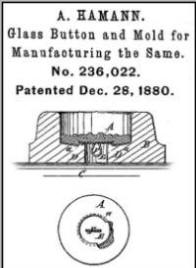
Introduction to Deknatel: Three years ago at my first button club meeting, an experienced collector advised me to examine the backs of buttons as part of my education process. At my second meeting, I brought a little black glass button with the backmark “PAT’D Dec. 28, 1880.” I was told it was a “Deknatel button” and was pointed to the Big Book of Buttons1 for further details. From there, I gathered earlier research information published in Return Engagement of Black Glass Buttons2 by Smith and Fuoss in 1952. I also obtained a copy of the original 1880 patent document. From these sources, I learned two things. First, the patented invention was an improvement in the attachment of metal shanks to glass buttons to reduce breakage or separation, a nagging failure of the time. Second, Deknatel was not the inventor. Rather, the inventor was August Hamann, an engraver/die maker, who assigned ownership of the patent to John Deknatel, his employer - a common practice that remains today. Was Hamann’s patent the only involvement by Deknatel in button inventions? I decided to look further.
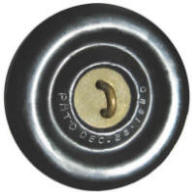 The Search is On: I took a two pronged approach. First, I tackled the
world wide web in the area of public census/birth/death records and newspaper archives. In terms of
John Deknatel, the man, the information reported by Smith and Fuoss
remains the gold standard notwithstanding today’s increased availability
of archive resources. I confirmed their findings that Deknatel was born
in the Netherlands, studied his glassmaking craft in France, and
emigrated to the United States in the 1860s where he became a
manufacturer of jewelry, glass products and buttons. I also found that
the whole Deknatel family was an enterprising bunch. At least two of
John’s brothers were involved in the glassmaking business and a third
established a box manufacturing company. I was able to identify only
limited additions to the 1952 article. Most of these were anecdotal fun
such as the late 1880 New York Times article reporting that John A.
Deknatel pledged $10/month to a New York convalescent home for older
ladies.
The Search is On: I took a two pronged approach. First, I tackled the
world wide web in the area of public census/birth/death records and newspaper archives. In terms of
John Deknatel, the man, the information reported by Smith and Fuoss
remains the gold standard notwithstanding today’s increased availability
of archive resources. I confirmed their findings that Deknatel was born
in the Netherlands, studied his glassmaking craft in France, and
emigrated to the United States in the 1860s where he became a
manufacturer of jewelry, glass products and buttons. I also found that
the whole Deknatel family was an enterprising bunch. At least two of
John’s brothers were involved in the glassmaking business and a third
established a box manufacturing company. I was able to identify only
limited additions to the 1952 article. Most of these were anecdotal fun
such as the late 1880 New York Times article reporting that John A.
Deknatel pledged $10/month to a New York convalescent home for older
ladies.
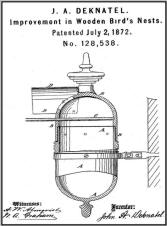 My search for Deknatel in the U.S. patent system3 took a different
turn. I became sidetracked and fascinated with the vast amount of
information associated with button inventions and, currently, have
collected the records for more than 1500 button related U.S. patents
before 1940. Many patents, like Hamann’s, involved the attempt to reduce the
failure of shanks, particularly on thin glass buttons. Much more
information on early button inventions can be found by clicking
here4. But I digress. From the patent review, I found about a dozen
additional patents that related directly or indirectly to John Deknatel
or his company.
My search for Deknatel in the U.S. patent system3 took a different
turn. I became sidetracked and fascinated with the vast amount of
information associated with button inventions and, currently, have
collected the records for more than 1500 button related U.S. patents
before 1940. Many patents, like Hamann’s, involved the attempt to reduce the
failure of shanks, particularly on thin glass buttons. Much more
information on early button inventions can be found by clicking
here4. But I digress. From the patent review, I found about a dozen
additional patents that related directly or indirectly to John Deknatel
or his company.
Deknatel’s Patents: The first of John A. Deknatel’s patents was completely unrelated to his glassmaking background and was granted in 1872 for an “Improvement in Wooden Bird’s-Nests”. Go figure!
The next seven patents were granted in 1882 for Deknatel inventions
having to do with specific face designs for buttons.
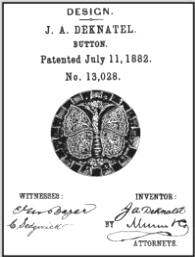 These “design”
patents were much different than Hamann’s Dec. 1880
“utility” patent in both the purpose and protection offered. By way of
background, the U.S. Patent Office issues three types of patents. The
most common is the “utility” patent which offers the inventor/assignee
20 years (17 years prior to 1995) of protection against others copying
the specific functional features of the invention. The second type,
“design patent”, was established in 1842 to cover the ornamental aspects
of a design. Design patents varied in duration from 3-1/2 years to 14
years based on the inventor’s needs and pocketbook. Finally, a third
type called a “plant patent” was established in 1930 for manmade plants
and is not relevant here.
These “design”
patents were much different than Hamann’s Dec. 1880
“utility” patent in both the purpose and protection offered. By way of
background, the U.S. Patent Office issues three types of patents. The
most common is the “utility” patent which offers the inventor/assignee
20 years (17 years prior to 1995) of protection against others copying
the specific functional features of the invention. The second type,
“design patent”, was established in 1842 to cover the ornamental aspects
of a design. Design patents varied in duration from 3-1/2 years to 14
years based on the inventor’s needs and pocketbook. Finally, a third
type called a “plant patent” was established in 1930 for manmade plants
and is not relevant here.
All of Deknatel’s design patents were granted for seven years. The
buttons I have found that match the patent drawings have similar
characteristics - black glass without luster like the butterfly shown
at the right. In addition, they all have an impressed face design and are of
very fine detail even in small sizes. The NBS guide, Classification of
Black Glass Buttons5 shows a design very similar to one of the seven
patents with a gold outline design. There might be other varieties. One is inclined
to ask why a glassmaker would initiate this uncommon and expensive
practice to protect button face designs. After all, one did not apply
for patents frivolously in 1882 since the cost was $30 for a patent
which, if escalated, would be about $700 in today’s currency. The most
likely answer lies in the cost of producing the molds and dies for
manufacturing the buttons. Remember, tools for producing these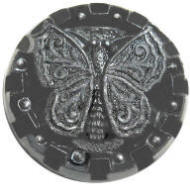 buttons
were all made by hand and, given the quality of the result, required a
very talented engraver. Deknatel’s design patents protected this
investment in time and labor giving him a proprietary marketing position
for the seven year duration. The other six design patents are shown below along with examples of the
black glass buttons manufactured to the patent drawings. The index
link below provides additional information and magnified images.
buttons
were all made by hand and, given the quality of the result, required a
very talented engraver. Deknatel’s design patents protected this
investment in time and labor giving him a proprietary marketing position
for the seven year duration. The other six design patents are shown below along with examples of the
black glass buttons manufactured to the patent drawings. The index
link below provides additional information and magnified images.
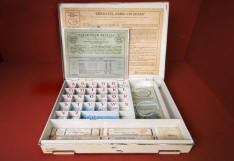 The
other three patents associated with the Deknatel family were not button
related. Finally, although unable to identify the patent, I found that
the Deknatel & Sons company manufactured “Deknatel Name-On Beads”6 (Ca.
1925) that were used in many hospitals to make up necklaces bearing
letters that spelled out an infant’s name. These matching identification
bracelets were worn by mother and child as a security measure against
babies being switched or stolen. Click on the image to the left to see a
magnified view.
The
other three patents associated with the Deknatel family were not button
related. Finally, although unable to identify the patent, I found that
the Deknatel & Sons company manufactured “Deknatel Name-On Beads”6 (Ca.
1925) that were used in many hospitals to make up necklaces bearing
letters that spelled out an infant’s name. These matching identification
bracelets were worn by mother and child as a security measure against
babies being switched or stolen. Click on the image to the left to see a
magnified view.
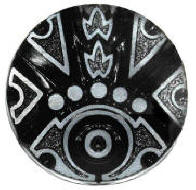 Button, Button, Who Made the Button?
We know from the
1888-1890 New York directory that John A. Deknatel was listed as a
button maker with his place of business at 2 Howard Street, New York.
So, can we now deduce that we know the “who” and “where” for the black
glass buttons with the patented face designs? Not so fast! We need to
remain mindful that the patent information only sets boundaries. It
seems very likely that buttons with the combined Deknatel patented face
design and the 1880 backmark were made in his New York glass
manufacturing plant. However, he could have allowed another manufacturer
to produce one or more of the designs and received royalties for the
permission. In addition, he might have sold the fine molds whose designs
were protected and again collected royalties. Finally, the designs
patented were only protected for seven years, after which, other
manufacturers could have legally copied the designs without attribution.
There might be a clue for the source of manufacture in the quality and
detail of the buttons. This, however, is a slippery slope since molds
only produce the “perfect” button when they are new. Over time, the
molds degrade until they finally have to be replaced. Because they were
hand made, you can often find small differences in the design of two
buttons that came from the same source and were intended to be
identical.
Button, Button, Who Made the Button?
We know from the
1888-1890 New York directory that John A. Deknatel was listed as a
button maker with his place of business at 2 Howard Street, New York.
So, can we now deduce that we know the “who” and “where” for the black
glass buttons with the patented face designs? Not so fast! We need to
remain mindful that the patent information only sets boundaries. It
seems very likely that buttons with the combined Deknatel patented face
design and the 1880 backmark were made in his New York glass
manufacturing plant. However, he could have allowed another manufacturer
to produce one or more of the designs and received royalties for the
permission. In addition, he might have sold the fine molds whose designs
were protected and again collected royalties. Finally, the designs
patented were only protected for seven years, after which, other
manufacturers could have legally copied the designs without attribution.
There might be a clue for the source of manufacture in the quality and
detail of the buttons. This, however, is a slippery slope since molds
only produce the “perfect” button when they are new. Over time, the
molds degrade until they finally have to be replaced. Because they were
hand made, you can often find small differences in the design of two
buttons that came from the same source and were intended to be
identical.
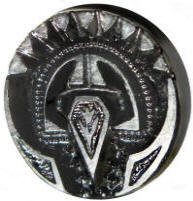 But what about the “who” and “where” for the buttons with the Dec. 28, 1880 backmark? The
arguments offered above are the same here with a couple of additional thoughts. First, the improved
shank attachment was apparently very successful given the large number
that have withstood the test of time. Thus, it seems likely that those
button makers whose shanks were prone to failure, might have paid
royalties to Deknatel during the 17 year protected period for the right
to use his design. However, manufacturers work hard to avoid royalty
payments and, in 1886, Leo Popper invented his own version of an
improved glass button shank which, while very similar to Hamann’s
design, was sufficiently different to be awarded its own patent. The
result for Popper was a reliable shank and no royalties to reduce his
profit margin. For those who copied the shank attachment feature after
the patent expired, the original patent mark would logically be retained
since consumers would relate this mark to a button whose shank was not
likely to fail. There is no impropriety here since Deknatel never owned the
patent backmark, just the shank attachment design feature for the
duration of the patent.
But what about the “who” and “where” for the buttons with the Dec. 28, 1880 backmark? The
arguments offered above are the same here with a couple of additional thoughts. First, the improved
shank attachment was apparently very successful given the large number
that have withstood the test of time. Thus, it seems likely that those
button makers whose shanks were prone to failure, might have paid
royalties to Deknatel during the 17 year protected period for the right
to use his design. However, manufacturers work hard to avoid royalty
payments and, in 1886, Leo Popper invented his own version of an
improved glass button shank which, while very similar to Hamann’s
design, was sufficiently different to be awarded its own patent. The
result for Popper was a reliable shank and no royalties to reduce his
profit margin. For those who copied the shank attachment feature after
the patent expired, the original patent mark would logically be retained
since consumers would relate this mark to a button whose shank was not
likely to fail. There is no impropriety here since Deknatel never owned the
patent backmark, just the shank attachment design feature for the
duration of the patent.
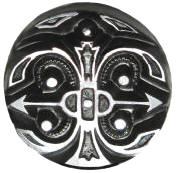 To put a specific example with the above possibilities, a friend and
mentor identified a potential issue related to one of the buttons shown
on an image accompanying the 1952 Smith and Fuoss article. Specifically,
an example shown as a button “made at the Deknatel factory” was the same
face design as used on buttons and molds she had acquired that
originated in Leo Popper’s work shop. The fact that two manufacturers
make buttons that look the same is not a stretch. First, I found no
design patent that would protect the face design in question. Second,
Smith and Fuoss reported that “Most mold patterns were known to have
been made at four or five widely separated glass houses at the same
period of time”. Other possibilities include the production and sale of
molds and dies between glass houses. Finally, without a patent (and
absent ethical standards) the same exceptional engraver might have been
engraving the same molds and dies for different manufacturers in the
same period.
To put a specific example with the above possibilities, a friend and
mentor identified a potential issue related to one of the buttons shown
on an image accompanying the 1952 Smith and Fuoss article. Specifically,
an example shown as a button “made at the Deknatel factory” was the same
face design as used on buttons and molds she had acquired that
originated in Leo Popper’s work shop. The fact that two manufacturers
make buttons that look the same is not a stretch. First, I found no
design patent that would protect the face design in question. Second,
Smith and Fuoss reported that “Most mold patterns were known to have
been made at four or five widely separated glass houses at the same
period of time”. Other possibilities include the production and sale of
molds and dies between glass houses. Finally, without a patent (and
absent ethical standards) the same exceptional engraver might have been
engraving the same molds and dies for different manufacturers in the
same period.
Conclusion: Sometimes the result of our research into the people who designed and manufactured our buttons is a lesson in what we do not or cannot know. It can be daunting to realize that you can find out more about scoundrels and scallywags than you can about the entrepreneurs and artists who made beautiful items we treasure as collectibles more than a hundred years later. Tracking down inventors using the patents they were granted has a special appeal. It is like looking at birth certificates for members of your button family tree. Whatever the technique and limitations, the fun of adding a bit of knowledge to our hobby is sufficient reward.
Click Here for Deknatel Buttons and Patents Index
Note (1) - This article was originally published in the 2009 Spring Edition of the North Carolina State Button Society Bulletin. The requirements for reprinting are (a) material is printed in its entirety; (b) credit is given to the NC State Button Society Bulletin; (c) material includes the author's by-line; and (d) a copy of the issue is sent to the North Carolina bulletin editor and the author. Anyone desiring to reprint this article may contact the author at for copies of the text and image digital files.
References:
(1) The Big Book of Buttons by Elizabeth Hughes and Marion Lester. Boyertown, PA: Boyertown Publishing Company, 1981.
(2) Return Engagement of Black Glass Buttons by Smith and Fuoss, 1952
(3) US Patent and Trademark Office, Patent Images, http://www.uspto.gov/. 2008
(4) Button Country Website, http://www.buttoncountry.com. 2009 (Patent examples under "Special Topics")
(5)Official National Button Society Classification and Competition Guidelines (Blue Book)
Acknowledgements:
Lillian Ward and Louella Yeargain who kindly provided the author with three of the Deknatel face design buttons used in this article.
Pat Koehler who set me on the path to study the backs of buttons (and many other lessons).
Katrinka Quirk and Betty Korostynski for inputs on Leo Popper and Deknatel respectively.